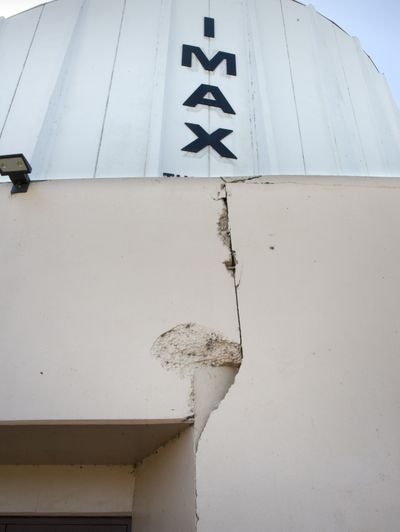Park’s Imax theater may be shuttered

The films playing on Eastern Washington’s largest movie screen loop through 41 rollers to feed the film up and down and around Spokane’s Imax projector.
Before a Tuesday showing of the newest release, “Great White Shark,” Dat Nguyen threads the film in a dazzling 2 minutes, 3 seconds. It took 13 minutes to rewind the film from the last showing. His speed allows for a nearly on-time start for the 11 o’clock show.
But there are at least two reasons his skill may not be useful much longer.
One, if the theater is to survive, it needs a digital projector.
Two, it’s unclear the theater will survive.
“I’m not planning to do this forever because I know it’s obsolete,” he said.
Nguyen is the most experienced projectionist for Riverfront Park’s Imax, but he’s only a temporary seasonal employee. The permanent projectionist was laid off at the end of last year when the Spokane Park Board voted to keep the theater open only half of 2013.
The future of the Imax is one of many big questions facing a committee planning the future of the park. Its ideas will be used by city leaders to create a tax to pay for extensive upgrades. The chairman of the committee, Inlander Publisher Ted McGregor, said he’s encouraging members to keep an open mind about the Imax.
But, he adds, “it need to at least break even.”
Spokane’s projector is original to the theater, built in 1978. And it works, by most accounts, astonishingly well. But as time goes on, fewer movies will be available on film.
Most older giant-screen theaters that are not part of a commercial multiplex haven’t made the switch yet to digital. What’s hurting the future most at the Riverfront screen is ticket sales. They have dropped significantly in the past few years, after its 30-year Imax contract expired and its exclusive right to play first-run Imax films in Spokane was yanked. Across the street, the River Park Square AMC opened a smaller Imax screen and plays digital new releases. Now, if the city’s Imax wants the draw of a Hollywood film, it must wait for at least a few weeks after its initial release.
Imax attendance last year was nearly half what it was in 2008, when more than 80,000 tickets were sold and it still showed first-run films.
Among the nearly 250 giant film screens in the world, the Riverfront Park Imax is the fourth-oldest still open, and the third-oldest in the United States, according to LF Examiner, a publication that covers the giant-screen movie industry. Its screen is slightly smaller than the average giant screen, but it is still five stories tall, at 53 by 69 feet, and only a tad smaller than the largest in Washington, at the Pacific Science Center in Seattle, according to LF Examiner.
Paul Fraser, who owns Blaze Digital Cinema Works, a consulting firm, said any giant-screen movie house that upgrades to digital almost certainly would add 3-D capability because it would add only minimally to the cost. He studied the Riverfront Park Imax in 2011 and determined that it would be reasonable to conclude that, if upgraded to digital and managed well, the theater could turn a profit again.
Kids leaving the theater after a Tuesday showing of the shark film expressed awe from the grandness of the experience. There were nearly 230 of them who saw the 11 a.m. show. A popular field trip attraction, the Imax is busy this time of year.
Kellie Breslin, a third-grade teacher at Opportunity Elementary School, said she brings her pupils to Riverfront Park every spring. Her class learns about ecosystems and life cycles at the end of the school year, so the trip always includes an Imax film about animals.
“It’s a special thing we get to do,” she said. “I’d hate to see it go away.”